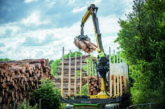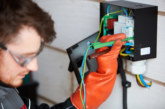PHPD talks to Dr Stephen Finnegan, Director of the Zero Carbon Research Institute (ZCRI) and Non-Executive Director of Dynamis Associates about what the housebuilding sector can do to reduce carbon emissions.
Last month we featured Dynamis Associates, a company bringing a service approach to energy provision to the property sector, installing Air Source Heat Pumps. Involved with the company is Dr Stephen Finnegan, lecturer in Sustainable Architecture at the University of Liverpool’s School of Architecture and Director of the Zero Carbon Research Institute. He has joined Dynamis as a Non-Executive Director as he sees their innovative approach as a step forward in the transition to a zero carbon future within the housebuilding industry.
Read: PHPD’s guide to heat pumps
“For housebuilding, I (and the vast majority of industry) believe that we must take a “fabric first” approach to house construction. Once the building is constructed in an efficient, sustainable and low carbon manner, we need then to look at how we heat and power our homes.
“There are two areas in the fight against carbon to consider. The first is operational emissions. The UK Government has set the construction industry the target of achieving net zero carbon in operation in all new homes by 2030. Essentially we have 10 years for all new buildings to either source their energy on site and/or purchase renewable energy off site. By 2050, all buildings will need to be net zero carbon in operation.
“The second area to focus on is the embodied carbon of a building. This includes the carbon emitted in every step of the production and life cycle of any given home. The materials used in construction, the origins of each product, the transport to site and end of life – the emissions of the entire process will need to be reduced by 40% by 2030, and by 100% by 2050 for all new buildings.
“In short, this is a big ask. However it is possible. Firstly, one of the biggest changes we can make is in the construction process itself. Products and materials must be sourced sustainably and when they arrive on site they must be installed correctly. Then they’ll work a lot more efficiently than if they are installed wrongly. Thermal bridging, for instance, is a huge contributor to heat loss in a building. Secondly, an industry-wide push towards heat pumps is possible and could dramatically reduce operational carbon emissions.
“Millions of heat pumps need to be installed over the next thirty years, which is a huge logistical operation. Companies like Dynamis have the potential to completely change the game by providing that third party service, taking the risks and the challenges on-board themselves. What’s more, because they install the heat pumps themselves and they are experts on the subject, housebuilders and developers can be assured that the installation and ongoing management will be done in the most efficient way.
“Installing heat pumps is only the first step. The next exciting opportunity is from switching energy supplier to consider a time of use tariff, the options for Solar PV and battery storage. I firmly believe that if we get this right, we can take people out of fuel poverty and make our homes power plants of the future, generating an oncome for the occupants.”
The opinions expressed by Dr Stephen Finnegan are provided in a private capacity. The University of Liverpool cannot accept responsibility for the comments made.









